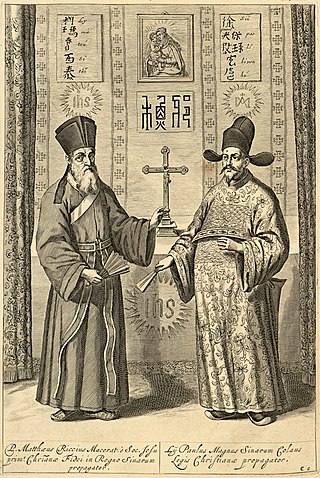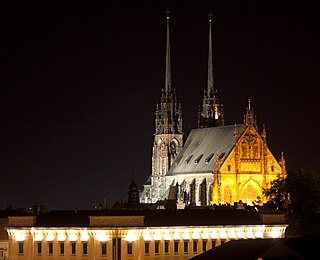The Catholic Church in Cuba is part of the worldwide Catholic Church, under the spiritual leadership of the Pope in Rome. Catholics make up approximately half of the population of Cuba. [1]
| Part of a series on the |
| Catholic Church by country |
|---|
 |
| |
The Catholic Church in Cuba is part of the worldwide Catholic Church, under the spiritual leadership of the Pope in Rome. Catholics make up approximately half of the population of Cuba. [1]
Catholicism has historically been the majority religion since Cuba's colonization. However, Communist Cuba is no exception to the ideological clash between Communism and religion that was common in communist countries. After Fidel Castro's ascent to power in 1959, he imposed restrictions on religious activities such as Christmas celebrations, and in 1962 barred personnel of the Church from joining the Communist Party of Cuba - following a communist tradition of Marxist-Leninist atheism. [2] However, Castro's efforts were not as successful as in traditionally communist countries such as the USSR or China.
When the Cold War ended, such restrictions were lifted and the atheist guidelines outlined in the Cuban Constitution were removed. Catholics have been able openly join the Party since 1990. In 1998 Pope John Paul II made an official visit to Cuba and met Fidel Castro in person. Castro honored the Pope publicly. Pope Benedict XVI visited in 2012, meeting both Fidel and Raúl Castro, as did Pope Francis in 2015.
The Catholic Church body in Cuba is governed by the Cuban Bishops Conference. There are over six million Catholics - around 60.5% of the total population [3] - although only about 2% attend mass. [4] The country is divided into three archdioceses [5] and eleven dioceses.
The Catholic Church in Cuba has taken on a more politically active role than in many other countries. It claims to have engaged in discussion with the government on issues such as political prisoners and free market reforms.
Catholics in Cuba have greater religious freedom than those in other Communist countries such as China, North Korea, and Vietnam. [6] [7]
The Catholic Patriotic Association, abbreviated CPA, is a state-managed nationalistic organization of Catholicism in the People's Republic of China. It was established in 1957 after a group of Chinese Catholics met in Beijing with officials from the Chinese Communist Party (CCP) and the Religious Affairs Bureau. It is the main organizational body of Catholics in China officially sanctioned and recognized by the Chinese government.

The Catholic Church in France is part of the worldwide Catholic Church in communion with the Pope in Rome. Established in the 2nd century in unbroken communion with the bishop of Rome, it is sometimes called the "eldest daughter of the church".

The Catholic Church in Benin is part of the worldwide Catholic Church, under the spiritual leadership of the Pope in Rome.

State atheism or atheist state is the incorporation of hard atheism or non-theism into political regimes. It is considered the opposite of theocracy and may also refer to large-scale secularization attempts by governments. To some extent, it is a religion-state relationship that is usually ideologically linked to irreligion and the promotion of irreligion or atheism. State atheism may refer to a government's promotion of anti-clericalism, which opposes religious institutional power and influence in all aspects of public and political life, including the involvement of religion in the everyday life of the citizen. In some instances, religious symbols and public practices that were once held by religions were replaced with secularized versions of them. State atheism in these cases is considered as not being politically neutral toward religion, and therefore it is often considered non-secular.

The Catholic Church in China has a long and complicated history. John of Montecorvino was the first Catholic missionary to reach China proper and first bishop of Khanbaliq during the Yuan dynasty (1271–1368).

Jaime Lucas Ortega y Alamino was a Cuban prelate of the Catholic Church who served as Archbishop of Havana from 1981 to 2016. He was appointed to the College of Cardinals in 1994, the second Cuban to hold that distinction.

The Brazilian Catholic Church, or Catholic Church in Brazil, is part of the worldwide Catholic Church, under the spiritual leadership of the Pope in Rome, and the influential National Conference of Bishops of Brazil, composed of over 400 primary and auxiliary bishops and archbishops. There are over 250 dioceses and other territorial jurisdictions in Brazil. The primate of Brazil is Dom Sérgio da Rocha.

The Catholic Church in the Czech Republic is part of the worldwide Catholic Church, under the spiritual leadership of the Pope, curia in Rome, and the Conference of Czech Bishops.

The Catholic Church in Indonesia is part of the worldwide Catholic Church, under the spiritual leadership of the pope in Rome. Catholicism is one of the six approved religions in Indonesia, the others being Islam, Protestantism, Hinduism, Buddhism, and Confucianism. According to official figures, Catholics made up 3.12 percent of the population in 2018. The number of Catholics is, therefore, more than 8.3 million. Indonesia is primarily Muslim, but Catholicism is the dominant faith in certain areas of the country.

The Catholic Church in Turkey is part of the worldwide Catholic Church, under the spiritual leadership of the Pope and the canonical leadership of the curia in Rome that is submitted to the Pope.

The Catholic Church in Guatemala is part of the worldwide Catholic Church, under spiritual leadership of the Pope, Curia in Rome and the Episcopal Conference of Guatemala. There are approximately 7.7 million Catholics in Guatemala, which is about 46% of the total population of 17.1 million citizens.

The Archdiocese of Edmonton is a Latin Church ecclesiastical territory or archdiocese in the Canadian civil province of Alberta. The archbishop's cathedral see is located in St. Joseph Cathedral, a minor basilica in Edmonton. The Archdiocese of Edmonton is the metropolitan see of its ecclesiastical province, which also contains two suffragan dioceses: the Dioceses of Calgary and Saint Paul in Alberta.
Christianity is the most widely professed religion in Cuba, with Catholicism being its largest denomination. A significant share of the Cuban population is either non-religious or practices folk religions.
Faustino Sainz Muñoz was a Spanish prelate of the Roman Catholic Church. He served as the Nuncio to Great Britain from 2004 until December 2010, having been appointed by Pope John Paul II in 2004.

Joseph Li Shan is a Chinese Catholic prelate who serves as Archbishop of Beijing. He was consecrated a bishop on 21 September 2007, at age 42 at a ceremony at Nan Tang in Xuanwumen. His main consecrator to become bishop was John Fang Xingyao. Before becoming archbishop he served as parish priest of Saint Joseph's Church in Wangfujing.

The Diocese of Sapporo is a Latin Church diocese of the Catholic Church located in Sapporo, Japan.
Christopher Columbus, on his first Spanish-sponsored voyage to the Americas in 1492, sailed south from what is now the Bahamas to explore the northeast coast of Cuba and the northern coast of Hispaniola. Columbus, who was searching for a route to India, believed Cuba to be a peninsula of the Asian mainland. The first sighting of a Spanish ship approaching Cuba was on 28 October 1492, probably at Bariay, Holguín Province, on the eastern point of Cuba.
The religious views of Fidel Castro are a matter of public interest.

Cuba–Holy See relations are foreign relations between the Holy See and the Republic of Cuba.